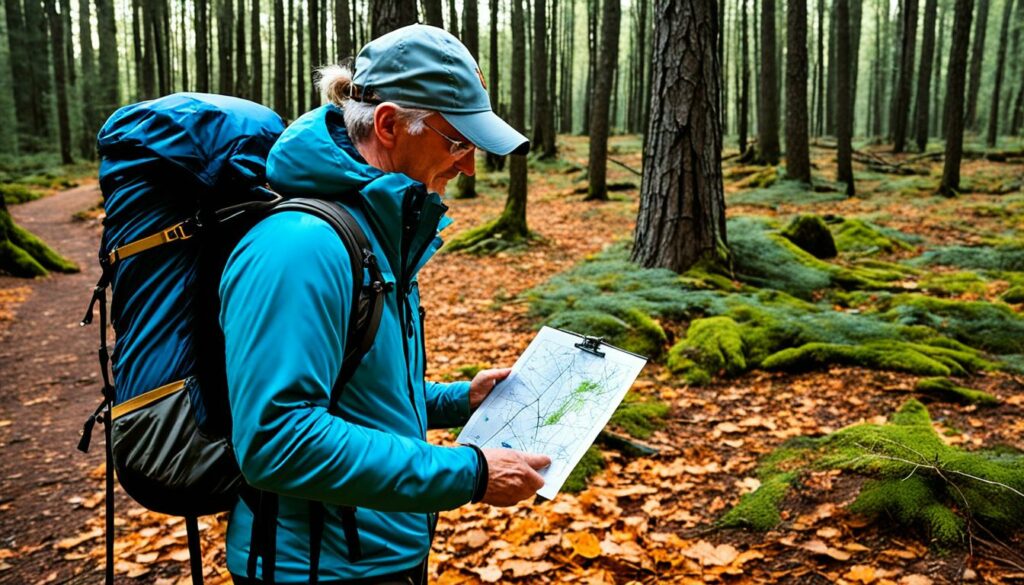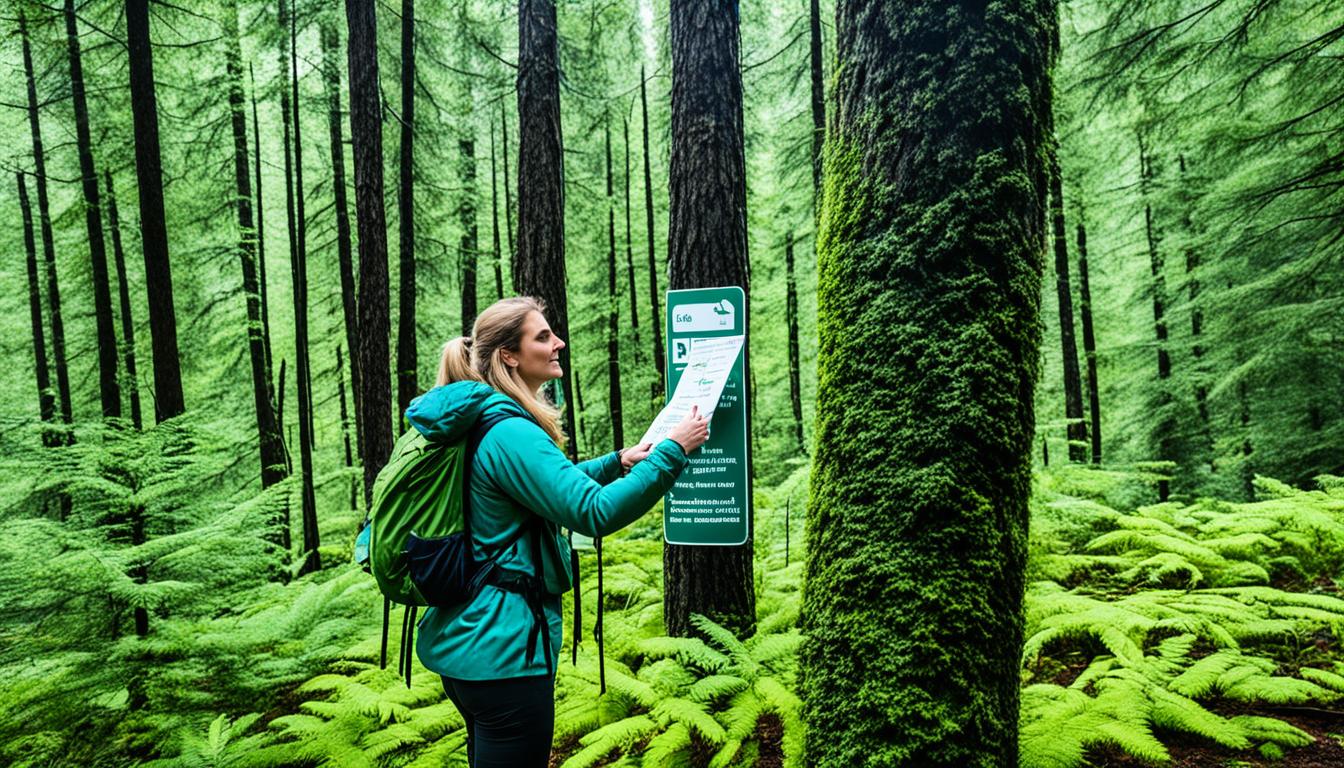Navigating the great outdoors is exciting but can be tough without modern tech. This article will show you how to use nature to find your way. You’ll learn to read nature’s signs and use the sun and stars for direction. This will open up a new world of adventure outside.
Key Takeaways
- Discover effective natural navigation techniques to find your way in the great outdoors
- Learn to use the sun, stars, and other environmental cues for orientation and path planning
- Develop the skills to navigate without relying on modern technology
- Enhance your outdoor exploration experience by confidently finding your way in the wilderness
- Unlock a new level of adventure by mastering natural navigation techniques
Introduction to Natural Navigation
Navigating the outdoors without tech might seem hard, but it’s a skill from centuries ago. It’s about using nature’s signs to find your way. This way, you connect more with the world around you.
By learning to read nature, you can find your way without maps or compasses. It’s a cool way to explore.
What is Natural Navigation?
Natural navigation uses the sun, stars, wind, and more to know where you are and where you’re going. It’s an old way of orientation without technology. It makes you pay attention to nature’s signals.
It helps you understand the world better. You get to use your senses more and figure out how to navigate on your own.
If you love hiking, exploring nature, or just being outside, learning natural navigation is great. It makes adventures more exciting and helps you grow in many ways.
“The ultimate of being successful is the luxury of giving yourself the time to do what you want to do.” – Leontyne Price
Orienting Yourself with Landmarks
Using natural ways to navigate, knowing landmarks is key. Big mountains, shiny lakes, and buildings can help you stay on course. They make it easier to know where you are and where you’re going.
Landmarks are like signs that help you know where you are. They keep you from getting lost. They are very useful whether you’re in a thick forest or on an open field.
It’s good to know the main features of the land before you go. Look at maps and learn about landmarks. This makes it easier to keep track of where you are and where you’re going.
By paying attention to the land and knowing what’s around you, landmarks can help you a lot. They make navigating the outdoors easier. Whether you’re hiking, camping, or exploring new places, using landmarks can really help.
“Mastering the art of natural navigation through the use of landmarks can be a game-changer.”
Staying Aware of Your Surroundings
It’s important to know your surroundings to navigate the outdoors well. Keep your eyes open and notice the details. This helps you find your way.
Use things like rivers, roads, or coastlines as “handrails”. They help you stay on track. This works well with other ways of finding your way.
Using Handrails for Guidance
Handrails, like landmarks or straight lines in the land, help you not get lost. These can be:
- Rivers, streams, or coastlines
- Ridgelines, valleys, or mountain ranges
- Roads, trails, or other man-made paths
Seeing these features helps you keep track of where you are. This method, with others, keeps you sure of your path.
“Paying attention to the details of your surroundings is the key to successful natural navigation. Use what’s around you to guide your way.”
Being aware of your environment and using natural guides is key. Stay alert, watch your surroundings, and let nature lead you.
Gathering Clues from the Environment
Learning to navigate naturally means paying attention to your surroundings. The world is full of clues, like the wind’s direction and animal behavior. By noticing these things, you can get better at finding your way and understand your environment better.
Understanding weather patterns is key in natural navigation. Watch the wind’s direction and strength, and notice changes in the clouds or rain. These signs can tell you where you are and where to go next.
Animals can also help you navigate. See how birds, insects, and other animals move and act. Are they looking for shelter or food? Their actions might suggest changes in the weather or other things that affect your path.
- Observe the direction and strength of the wind
- Monitor changes in cloud cover and precipitation
- Observe the behavior of local wildlife
- Look for changes in plant life and vegetation
Also, notice the plants around you. Their growth, color, and where they stand can tell you a lot. They can show where you are, the soil’s quality, and even the time of day or season.
| Environmental Clue | Potential Insight |
|---|---|
| Wind direction | Indication of your location relative to geographic features |
| Animal behavior | Approaching changes in weather or other environmental factors |
| Plant life | Information about soil quality, time of day, and seasonal changes |
By improving your natural navigation skills, you’ll get better at using environmental clues. This will help you move through the outdoors with ease and a deeper respect for the observation skills needed to navigate.

Natural Navigation Techniques
Navigating the outdoors is exciting and rewarding. It’s key to use the sky above us. Learning to read the sun and stars helps you stay on track. This is true even in places you’ve never been before.
Navigating Using the Sun
Watching the sun’s position is a great way to navigate. It shows you the directions and where you are. You can also make a simple compass with your watch and the sun.
Navigating Using the Stars
At night, the stars light your way. In the North, Polaris is a steady star to follow. In the South, the Southern Cross helps you find directions. Knowing the stars lets you move through the dark with ease.
Learning to navigate with the sun and stars is key for outdoor lovers. These skills help you explore the wilderness with confidence. They let you connect with nature and find your way, no matter where you go.
Using the Moon for Navigation
The sun and stars are great for finding your way, but the moon helps too. Watching the moon’s phases and where it moves in the sky tells you about your location and the time. This can be very useful.
The moon changes from new to full and back, like a natural calendar. Knowing when the moon rises and sets helps you know the day’s direction. This is very handy for finding your way.
The moon is more than just a phase tracker. Its position in the sky gives you direction clues. It’s a great tool to use with other ways of finding your way.
Lunar Phases and Timing
Tracking the moon’s phases is a simple way to navigate. It goes through a cycle from new moon to full moon and back. This cycle helps you know the time.
- New moon: The moon is not visible in the sky.
- Waxing crescent: The moon appears as a slim, crescent-shaped sliver in the western sky after sunset.
- First quarter: The moon appears half-illuminated on the right side.
- Waxing gibbous: The moon appears more than half-illuminated and is visible in the sky for a longer period.
- Full moon: The moon is fully illuminated and appears large in the sky.
- Waning gibbous: The moon appears more than half-illuminated but is decreasing in size.
- Last quarter: The moon appears half-illuminated on the left side.
- Waning crescent: The moon appears as a slim, crescent-shaped sliver in the eastern sky before sunrise.
Watching the moon’s phase and where it is in the sky helps you guess the time. It also tells you where you might be.

Directional Clues from the Moon
The moon’s position in the sky also gives direction clues. It rises in the east and sets in the west, like the sun. Knowing where the moon is can tell you which way is east and west.
The moon’s angle in the sky also hints at the time. A high moon means it’s late, a low moon means it’s early. This helps with finding your way, especially with other signs from nature.
Using the moon’s phases, timing, and position makes you better at navigating. The moon is a great guide that’s always there to help you.
Natural Navigation Techniques
Outdoor skills and wilderness exploration love natural navigation. These methods let adventurers find their way without modern tech. By using the world around us, you can understand your area better and navigate with ease.
Reading the sun’s position is a key skill. It helps you know which way is north. This is super useful in open areas or new places.
The stars are also great for finding your way. By knowing the night sky, you can use the North Star and constellations to guide you. This is really helpful in the dark or when it’s cloudy.
The world around us has many clues to help us navigate. Spotting landmarks, noticing plant patterns, and following water can help you stay on track. These skills are great for the wilderness.
| Natural Navigation Technique | Key Benefits |
|---|---|
| Sun Tracking | Determines cardinal directions, helps orient yourself |
| Celestial Navigation | Provides direction-finding using stars and constellations |
| Environmental Cues | Leverages landmarks, vegetation patterns, and water flow to stay oriented |
Learning these natural navigation skills makes outdoor adventures better. It deepens your bond with nature and helps you navigate confidently. Whether you’re in a forest, desert, or by the sea, these methods will guide you.
Conclusion
Learning how to navigate naturally can change how you see the outdoors. It lets you use the sun, stars, and nature to find your way. You’ll never worry about getting lost again.
This skill is great for everyone, from experts to beginners. It makes your outdoor adventures better and helps you understand nature more.
Getting good at natural navigation makes you feel more connected to the earth. It teaches you to use landmarks and stay alert. This article has given you the tools to navigate easily.
Start your next adventure with a new sense of direction. Natural navigation is a powerful skill. It makes you feel more self-sufficient.
The journey of learning natural navigation is just as important as the end result. Enjoy the beauty of nature and learn from its signs. Feel proud of finding your way without technology.
The wilderness has many secrets. With natural navigation, you can discover them. You hold the key to unlocking these secrets.
FAQ
What is natural navigation?
How can landmarks help with natural navigation?
Why is it important to stay aware of your surroundings?
How can using “handrails” help with natural navigation?
How can the sun be used for natural navigation?
How can the stars be used for natural navigation?
How can the moon be used for natural navigation?
Source Links
- Natural Navigation Methods: 5 Ways to Win – natureofthenorth.co – https://natureofthenorth.co/basics/natural-navigation-methods/
- How To Not Get Lost In The Woods – https://nature-mentor.com/natural-navigation-techniques/
- The Lost Art of Reading Nature’s Signs: Use Outdoor Clues to Find Your Way, Predict the Weather, Locate Water, Track Animals – and Other Forgotten Skills (Natural Navigation) – https://whiteoakbooks.net/book/9781615192410
